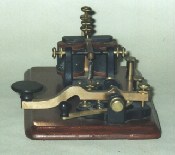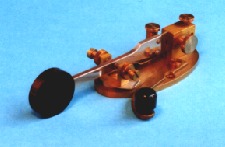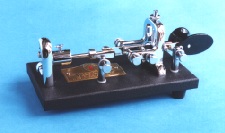Development of the Morse Key
Since the first Morse telegraph systems were introduced, an enormous variety
of Morse keys have been constructed. From Straight keys including the Camelback
Morse key, to automatic Morse keyers such as the Vibroplex, their development
has seen many new innovations, and enormous changes in style. Even today many
people enjoy sending Morse Code using these Morse keys. While some may say that
they are simply a switch, this is most certainly not the case. Morse keys have
been the subject of over 300 patents in the USA alone, and they have undergone a
considerable amount of development. The way in which keys have developed since
the very first ones used by Morse himself is a fascinating story. Some styles of
key are quite familiar, whilst others have quite unusual attributes and as a
result many people find collecting keys a fascinating pastime.
The first Morse keys arrived at the very beginning of the Morse telegraph
system in 1844. A few weeks before the demonstration of the first line between
Washington and Baltimore in the USA, Vail used a system of opening and closing
the circuit using a simple switch. Vail described the operation of the device
saying that it worked "in much the same manner as a key closes a door". He built
a very simple device with two contacts that needed to be pushed together to
close the circuit. It was made using "springy" brass and was mounted on a wooden
base. He called the device a "correspondents", the name that had been sued for
earlier sending devices. This key was used for the first demonstration, but
within six months he had developed a new type of key using a lever and a
fulcrum, and this same format is used for manual keys today. For anyone wanting
to see this "Lever Correspondents", it is on view in the Smithsonian Institute
in the USA.
With the explosion in the growth of the Morse telegraph system, many keys
were needed. The first ones were very crude, but quickly the idea of operator
comfort needed to be taken into consideration as operators had long periods of
operation. New keys were produced that made operation much easier. One of the
first was known as the "camelback" - a name that resulted from the shape of the
lever. Unlike the lever correspondent a spring was not considered necessary
because the curved shape of the lever placed the centre of gravity towards the
back of the lever away from the operator. In this way it naturally remained open
or in the rest position. Whilst the first camelbacks did not have springs, two
years later the first springs were added, and later in 1860, George Phelps, the
chief engineer with Western Union made further improvements that made the keys
much lighter and easier to use.

A camelback key.
This one dates from between 1850 and 1860. It has no adjustment on the spring
and therefore dates from before 1860. Note the "hump" in its back that gives it
the name
Keys continued to be used in ever-increasing numbers and their development
progressed. The next major step forward occurred when James Bunnell introduced
his "Triumph Key" in 1881. The basic design involved a steel lever with an
integral trunnion or fulcrum. A hollow oval frame made the key very light and
easy to use. These keys provided a number of advantages. Early keys suffered
from the fact that the lever would come loose from the press fit trunnion. As a
result of the improvements this style of key was produced in large quantities by
a number of companies including Western Electric, Signal Electric and of course
the Bunnell company itself.

A steel lever key.
This one was manufactured around 1920 but it follows the basic design introduced
by James Bunnell in 1881

Post Office Key
European keys often tended to be heavier than their US counterparts. This
British Post office key dates from around 1900 and was manufactured by Walters
Electrical
Despite these improvements difficulties were still being experienced.
Operators were working very long hours and suffering from wrist pains. These
were known as telegraphers cramp, or paralysis, and this arose from the large
number of movements that needed to be made. TO help overcome this Bunnell
introduced a new form of key in 1888 known as the sideswiper. Instead of using
an up and down action the sideswiper used a side to side action with contact
being made when the key was moved to either side. A rest or off position was in
the centre.

A sideswiper
Note the different type of construction with the paddle
The sideswiper was a great improvement for telegraphers. The incidence of
telegraphers cramp reduced significantly. The next step in the development of
keys was the semi-automatic or "bug" key. The first major step in the automation
of Morse generation appeared in 1902 when Charles Yetman received his patent for
what he called a telegraphic transmitter. This consisted of a typerwriter
keyboard that converted the key depressions into Morse characters. The idea did
not catch on because the unit was large and expensive.
A year later Horace martin introduced a machine called an Autoplex. This was
battery powered and had a vibrating arm to generate the dots. Production of
these items was very slow and only continued until 1905. However in 1904 Martin
introduced a mechanical bug in 1904 he called a Vibroplex. It used a vibrating
arm to generate the dots. Martin filed the patent for his idea on 7th
May 1904, but he was not the only person working along these lines. A man named
William Coffe filed a patent on 11th January 1904. This was very
general in its wording encompassing many aspects of keyers, and as a result it
was granted after that of Martin's. As a result many legal battles were fought.
The Vibroplex was very successful and can still be bought today.

A modern version of the original Vibroplex
With the advancement of electronics, fully automatic keyers that generated
dots and dashes were eventually produced. Some of the earliest designs date from
the 1940s, one even appeared in the April 1940 edition of QST, the magazine of
the American Radio Relay League. Now with the introduction of integrated circuit
technology keys that can store strings of code can be made easily and cheaply.
Computers can also be used to generate and even read Morse code.
This is only a short summary of the developments that occurred with Morse
keys, and naturally many interesting facts and keys have had to be omitted
because of space.
|

